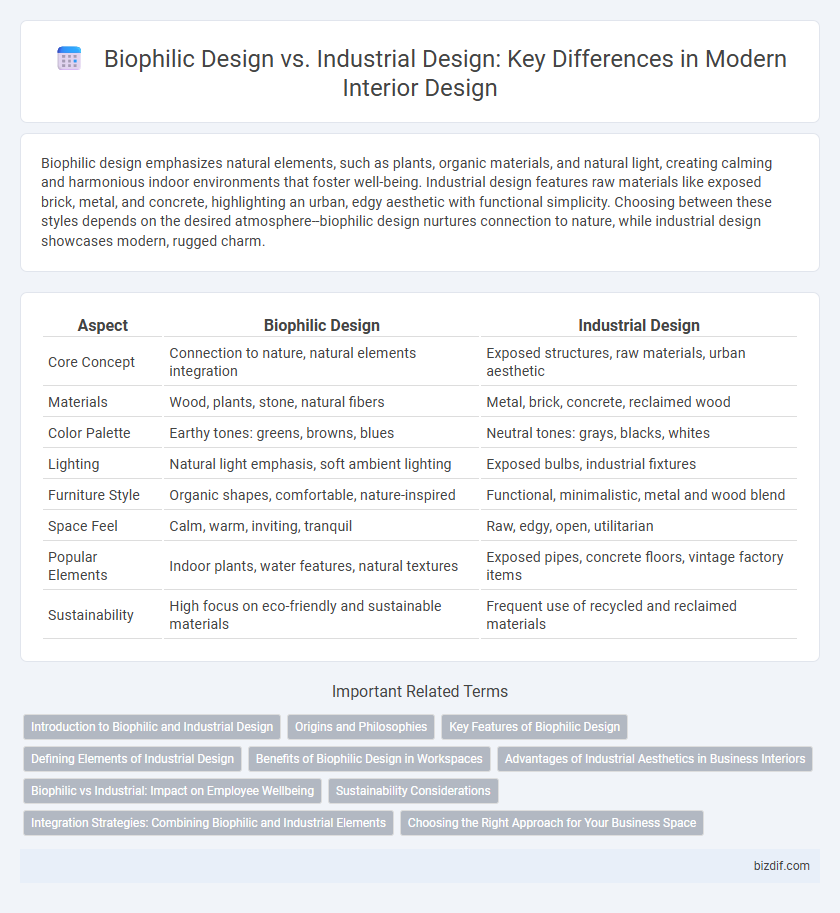Biophilic design emphasizes natural elements, such as plants, organic materials, and natural light, creating calming and harmonious indoor environments that foster well-being. Industrial design features raw materials like exposed brick, metal, and concrete, highlighting an urban, edgy aesthetic with functional simplicity. Choosing between these styles depends on the desired atmosphere--biophilic design nurtures connection to nature, while industrial design showcases modern, rugged charm.
Table of Comparison
| Aspect | Biophilic Design | Industrial Design |
|---|---|---|
| Core Concept | Connection to nature, natural elements integration | Exposed structures, raw materials, urban aesthetic |
| Materials | Wood, plants, stone, natural fibers | Metal, brick, concrete, reclaimed wood |
| Color Palette | Earthy tones: greens, browns, blues | Neutral tones: grays, blacks, whites |
| Lighting | Natural light emphasis, soft ambient lighting | Exposed bulbs, industrial fixtures |
| Furniture Style | Organic shapes, comfortable, nature-inspired | Functional, minimalistic, metal and wood blend |
| Space Feel | Calm, warm, inviting, tranquil | Raw, edgy, open, utilitarian |
| Popular Elements | Indoor plants, water features, natural textures | Exposed pipes, concrete floors, vintage factory items |
| Sustainability | High focus on eco-friendly and sustainable materials | Frequent use of recycled and reclaimed materials |
Introduction to Biophilic and Industrial Design
Biophilic design integrates natural elements such as plants, natural light, and organic materials to enhance occupant well-being and productivity. Industrial design emphasizes raw, exposed materials like steel, brick, and concrete, creating a minimalist and utilitarian aesthetic. Both styles influence interior spaces by prioritizing different sensory experiences and environmental connections.
Origins and Philosophies
Biophilic design originates from the concept of connecting humans with nature, emphasizing natural elements, organic materials, and wellness to enhance mental and physical well-being. Industrial design stems from the early 20th-century industrial revolution, focusing on raw materials like metal and concrete, with an aesthetic that celebrates utility, mechanical functionality, and urban ruggedness. Both philosophies reflect distinct cultural shifts: biophilic design prioritizes ecological harmony, while industrial design highlights technological progress and urban development.
Key Features of Biophilic Design
Biophilic design integrates natural elements such as plants, natural light, and organic materials to enhance well-being and productivity in interior spaces. Key features include the use of natural textures, daylight optimization, and views of nature to create a calming, restorative environment. This approach contrasts with industrial design's emphasis on raw materials like metal and concrete, prioritizing warmth and connection to nature over utilitarian aesthetics.
Defining Elements of Industrial Design
Industrial design emphasizes raw materials such as exposed brick, metal, and concrete, showcasing structural elements like beams and pipes to create an unfinished, utilitarian aesthetic. Its color palette typically includes grays, blacks, and earth tones, complemented by minimalist furniture with clean lines and functional forms. The overall atmosphere thrives on open spaces and high ceilings, reflecting a factory-inspired, rugged charm that contrasts sharply with the natural integration seen in biophilic design.
Benefits of Biophilic Design in Workspaces
Biophilic design in workspaces enhances employee well-being by integrating natural elements such as plants, natural light, and organic materials, reducing stress and boosting creativity. Studies show that environments incorporating biophilic principles lead to increased productivity and improved cognitive function compared to traditional industrial design settings. This approach fosters a healthier, more engaging atmosphere that supports mental health and collaboration among team members.
Advantages of Industrial Aesthetics in Business Interiors
Industrial design in business interiors offers durability through the use of raw materials like steel and concrete, making spaces highly resilient to wear and tear. Its open layouts and exposed structural elements encourage collaborative environments and enhance spatial flexibility. The minimalist aesthetic reduces clutter, promoting a clean and efficient atmosphere that aligns with modern corporate branding.
Biophilic vs Industrial: Impact on Employee Wellbeing
Biophilic design enhances employee wellbeing by incorporating natural elements such as plants, natural light, and organic materials, which reduce stress and increase productivity. In contrast, industrial design, characterized by exposed brick, metal, and minimalistic aesthetics, may create a more stimulating but less comforting environment. Studies reveal that workplaces with biophilic elements experience lower absenteeism and higher job satisfaction compared to traditional industrial-design offices.
Sustainability Considerations
Biophilic design integrates natural elements such as plants, natural light, and organic materials, promoting sustainability through improved air quality and energy efficiency. Industrial design often uses raw materials like metal and concrete, which can have higher environmental impacts but may incorporate recycled or repurposed components to enhance sustainability. Both design approaches offer unique eco-friendly strategies, with biophilic design emphasizing natural ecosystem balance and industrial design focusing on material reuse and durability.
Integration Strategies: Combining Biophilic and Industrial Elements
Integration strategies for combining biophilic and industrial design focus on balancing natural materials like wood, stone, and greenery with raw metallic finishes, exposed brick, and concrete surfaces. Incorporating large windows and natural light enhances biophilic elements, while metal fixtures and minimalist furniture maintain the industrial aesthetic. Layering textures and blending organic shapes with geometric forms creates a harmonious space that merges urban edge with nature-inspired tranquility.
Choosing the Right Approach for Your Business Space
Biophilic design enhances business spaces by integrating natural elements like plants, natural light, and organic materials to boost employee well-being and productivity. Industrial design emphasizes raw, unfinished aesthetics with exposed brick, metal fixtures, and concrete surfaces, creating a modern, edgy atmosphere often suited for creative industries. Selecting the right approach depends on your brand identity and workspace goals, balancing comfort with functionality to foster innovation and employee satisfaction.
Biophilic design vs Industrial design Infographic

 bizdif.com
bizdif.com